Why Is My Dog Panting While Resting – Causes Explained
Discover the underlying reasons behind your dog’s panting while resting, and learn when to seek veterinary care for this concerning behavior.
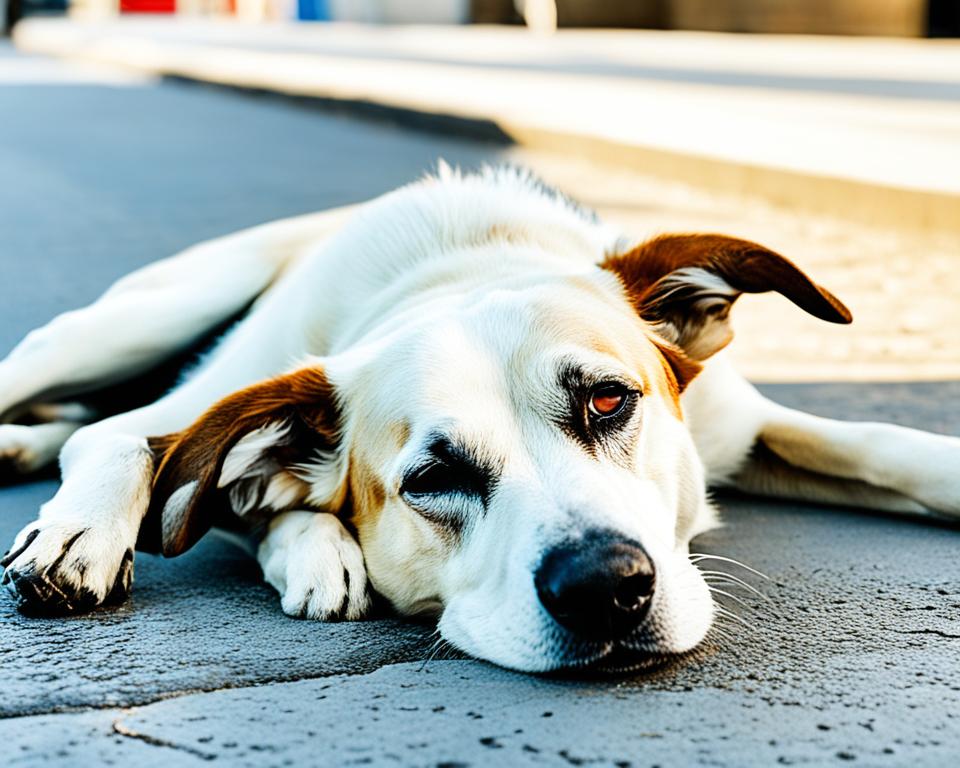
Have you ever wondered why your dog pants while resting? Panting is a natural cooling mechanism for dogs, but when it occurs while they are at rest, it can be perplexing and possibly concerning for pet owners like you. What could be causing your dog to pant while at rest, and should you be worried? In this section, we will delve into the various factors that can lead to panting in dogs while they are resting, providing you with a better understanding of this behavior and its underlying causes.
Panting is a common behavior in dogs, especially when they are hot or excited. However, excessive panting while resting can be a sign of an underlying issue. By knowing why your dog is panting while resting, you can identify potential health problems and determine if veterinary care is necessary.
In the next sections, we will explore different factors that can contribute to panting in dogs while they are at rest. We will discuss the normal purpose of panting as a cooling mechanism, identify when panting becomes abnormal, and examine various triggers for excessive panting. Additionally, we will explore how pain, diseases, medications, and anxiety can affect a dog’s respiratory system and lead to panting. So, why is my dog panting while resting? Let’s find out together and uncover the underlying causes behind this behavior.
Canine Panting: A Natural Cooling Mechanism
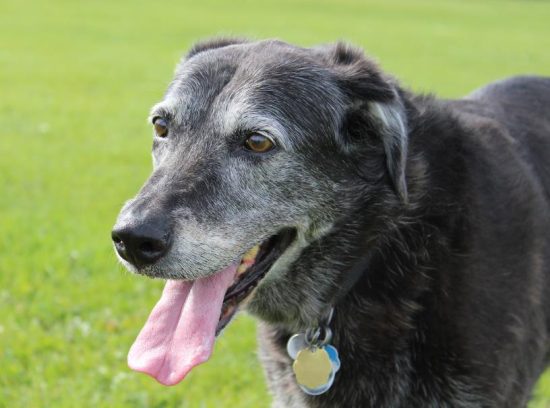
Panting is a natural behavior in dogs and serves as a mechanism for cooling down. Dogs cannot sweat like humans do, so they rely on panting to regulate their body temperature. By panting, dogs circulate air through their respiratory system, allowing moisture in their mouth and airway to evaporate and cool their bodies.
This natural cooling process helps dogs maintain their internal body temperature within a safe range, especially during periods of increased physical activity or when exposed to higher temperatures.
Dog owners often wonder why their pets pant excessively, especially while resting. It’s important to understand that panting is a normal part of a dog’s thermoregulation system. During panting, dogs take in rapid breaths, increasing their respiration rate and facilitating heat dissipation. The moisture in their mouth and airway evaporates, in turn cooling their bodies.
Understanding the purpose of dog panting is crucial for dog owners to differentiate between normal panting and excessive panting that could indicate an underlying health issue. Next, we will explore more about panting and delve into the various factors that can trigger excessive dog panting in different situations.
Recognizing Abnormal Panting: When You Should Be Concerned
While panting is a normal behavior for dogs, there are instances where it may be considered abnormal. It is crucial for pet owners to recognize excessive panting in dogs and understand when it may be indicative of an underlying issue. Identifying abnormal respiratory rates and distinguishing between panting and rapid breathing are essential for determining if your dog’s panting requires veterinary attention.
Identifying Abnormal Respiratory Rates
One way to recognize abnormal panting in dogs is by evaluating their respiratory rates. A normal respiratory rate for a resting dog is typically between 10 to 30 breaths per minute. If your dog is panting excessively and their respiratory rate exceeds this range, it may be a cause for concern. Pay attention to any sudden changes or significant increases in your dog’s breathing patterns, as these could indicate an underlying health problem.
The Differences Between Panting and Rapid Breathing
It is important to differentiate between panting and rapid breathing, as they can have distinct causes and implications. Panting is characterized by open-mouthed, rapid breaths that help dogs cool down. On the other hand, rapid breathing is characterized by fast, shallow breaths that appear more desperate and may indicate respiratory distress or other health issues.
To identify abnormal panting, observe the nature and duration of your dog’s breathing. Excessive panting tends to be prolonged and persistent, even when the dog is at rest. If you notice your dog exhibiting rapid breathing, take note of any accompanying signs of distress such as coughing, wheezing, or labored breathing.
| Panting | Rapid Breathing |
|---|---|
| Open-mouthed, rapid breaths | Fast, shallow breaths |
| Aids in cooling down the body | May indicate respiratory distress or health issues |
| Prolonged and persistent, even at rest | Often accompanied by signs of distress |
Why Is My Dog Panting While Resting?
While panting in dogs is a natural behavior, it can be concerning when it occurs while they are resting. In this section, we will explore two common triggers that can cause dogs to pant while at rest: environmental factors and stress/anxiety-related panting.
Environmental Factors and Overheating
Hot weather and overheating can be significant factors that lead to excessive panting in dogs while resting. Dogs rely on panting as a cooling mechanism, especially when their body temperature rises. When exposed to high temperatures or inadequate ventilation, dogs may struggle to regulate their body temperature effectively, leading to increased panting.
If your dog is panting while resting in hot weather, it is crucial to ensure they have access to shade, fresh water, and a cooler environment. Avoid leaving your dog in a confined space with limited airflow or in a parked car, as these conditions can rapidly raise their body temperature and put them at risk of heatstroke.
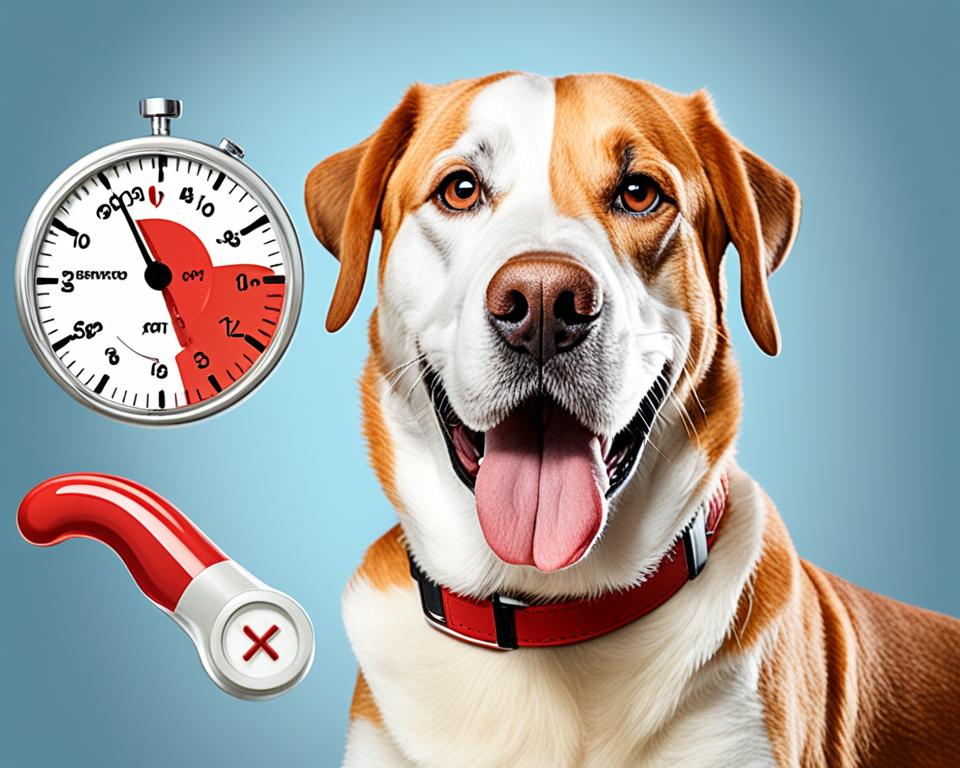
Stress and Anxiety-Related Panting
Stress and anxiety are emotional triggers that can cause dogs to pant while resting. Just like humans, dogs can experience various forms of stress, including separation anxiety, fear, or phobias. These emotions can manifest in increased respiratory rates, leading to panting.
If you notice that your dog is panting while resting and displaying signs of stress or anxiety, it is essential to address the underlying cause. Providing a safe and comforting environment, incorporating positive reinforcement training techniques, or seeking professional guidance from a certified dog behaviorist can help manage and alleviate your dog’s stress and anxiety.
Pain-Induced Panting: Signs Your Dog May Be Suffering
Pain can be a significant cause of panting in dogs while resting. When dogs experience pain, whether from an injury or underlying medical condition, they may pant as a way to cope with discomfort. It’s crucial for pet owners to recognize the signs of pain-induced panting in their dogs to ensure their well-being and provide the necessary veterinary care.
Pain-induced dog panting can manifest in various ways, and understanding these signs can help you identify if your dog is suffering. Some common signs of pain in dogs include:
- Increased panting or rapid breathing
- Limping or reluctance to move
- Whining or whimpering
- Changes in appetite or eating habits
- Restlessness or agitation
It’s important to note that each dog may show different signs of pain, so it’s crucial to pay attention to any changes in their behavior or demeanor. For example, some dogs may become more withdrawn or exhibit aggressive behavior when in pain.
If you notice these signs or suspect that your dog may be experiencing pain, it’s essential to consult your veterinarian. Your vet will be able to assess your dog’s condition, perform any necessary diagnostic tests, and recommend appropriate pain management strategies.
| Signs of Pain in Dogs | Actions to Take |
|---|---|
| Increased panting or rapid breathing | Contact your veterinarian for an examination and potential pain management options. |
| Limping or reluctance to move | Seek veterinary care to determine the cause of the limping and provide appropriate treatment. |
| Whining or whimpering | Consult your veterinarian to identify the source of the pain and develop a plan for pain relief. |
| Changes in appetite or eating habits | Discuss any changes in your dog’s eating habits with your veterinarian to rule out underlying medical conditions. |
| Restlessness or agitation | Bring your dog to the vet for a comprehensive evaluation to determine the cause of restlessness and provide appropriate care. |
The Role of Disease in Excessive Dog Panting
Various medical conditions can contribute to excessive panting in dogs while they are resting. Understanding the link between disease and excessive panting can help pet owners identify potential health issues and seek appropriate veterinary care for their dogs.
When it comes to diseases causing dog panting, pet owners should be aware of several medical conditions. These conditions can lead to abnormal respiratory rates in dogs, resulting in excessive panting even when the dog is at rest.
Some medical conditions that may contribute to excessive panting in dogs include:
- Heart disease
- Lung disorders
- Obesity
- Anemia
- Infections
Heart disease, such as congestive heart failure, can impair a dog’s ability to circulate blood efficiently, resulting in panting. Lung disorders, such as bronchitis or pneumonia, can cause respiratory distress and increased panting. Obesity, which strains a dog’s respiratory system, can also lead to excessive panting. Anemia, characterized by a lack of red blood cells, can impact oxygen delivery to tissues, causing panting. Lastly, infections, such as pneumonia or kennel cough, can cause respiratory symptoms that increase dogs’ panting.
Pet owners need to recognize these underlying medical conditions and seek appropriate veterinary care for their dogs. A thorough veterinarian examination and any necessary diagnostic tests can help determine the cause of excessive panting and guide the appropriate treatment plan.
| Medical Condition | Symptoms | Treatment |
|---|---|---|
| Heart Disease (Congestive Heart Failure) | – Difficulty breathing – Coughing – Bluish gums – Exercise intolerance |
– Medications (e.g., diuretics, ACE inhibitors) – Diet modifications – Cardiac care management |
| Lung Disorders (Bronchitis, Pneumonia) | – Coughing – Difficulty breathing – Rapid breathing – Fever |
– Antibiotics – Anti-inflammatory medications – Cough suppressants – Oxygen therapy if necessary |
| Obesity | – Excessive weight – Difficulty moving or exercising – Labored breathing |
– Dietary changes (e.g., portion control, balanced diet) – Exercise regimen – Weight management plan |
| Anemia | – Weakness – Pale gums – Rapid breathing – Fatigue |
– Iron supplementation – Blood transfusions (in severe cases) – Treating underlying cause of anemia |
| Infections (Pneumonia, Kennel Cough) | – Coughing – Sneezing – Difficulty breathing – Nasal discharge |
– Antibiotics (bacterial infections) – Antiviral medications (viral infections) – Cough suppressants |
Pet owners must monitor their dogs closely for signs of excessive panting and consult a veterinarian if they have concerns. Early detection and treatment of underlying medical conditions can significantly improve a dog’s quality of life and prevent further complications.
Impact of Medications: Understanding Side Effects
Certain medications can have an impact on a dog’s respiratory system, leading to increased panting. It’s important for pet owners to be aware of the potential side effects of dog medications and recognize the signs of panting as a medication side effect. Understanding these effects can help ensure the health and well-being of your furry friend.
Corticosteroid Medications and Increased Panting
Corticosteroid medications, commonly prescribed for various ailments in dogs, are known to cause increased panting as a side effect. These medications work by suppressing the immune system and reducing inflammation. While they can be effective in managing certain conditions, such as allergies and arthritis, dogs may experience excessive panting as a result.
If your dog is on corticosteroid medications and panting excessively, it is essential to consult with your veterinarian. They can assess the dosage and duration of the medication and determine if the panting is within expected limits or requires adjustment. Your veterinarian may recommend alternative treatment options or adjust the prescription to alleviate the panting side effect.
Recognizing Other Medications That Affect Breathing
In addition to corticosteroids, there are other medications that can affect a dog’s breathing and cause panting. These may include certain pain medications, sedatives, and anti-anxiety medications. While these medications can provide relief for various conditions, they can also have respiratory side effects.
If you notice excessive panting in your dog after starting a new medication, it is crucial to consult with your veterinarian. They can evaluate the medication’s potential side effects and determine if an alternative treatment option is necessary. It’s important not to alter or discontinue any medication without professional guidance, as it may potentially worsen your dog’s condition.
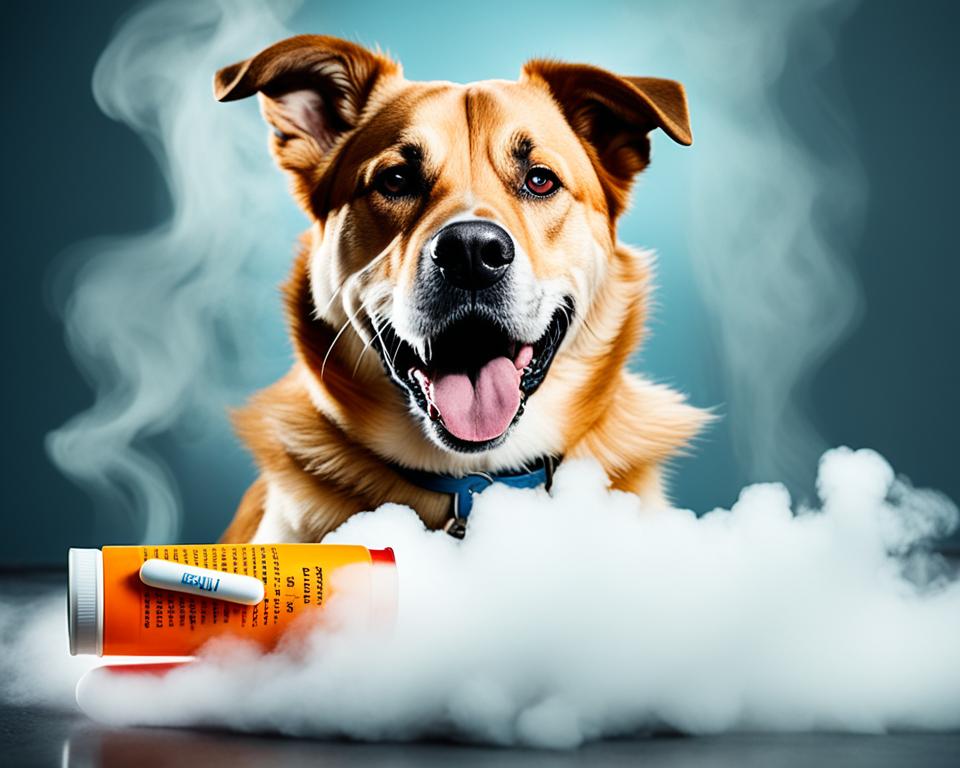
| Medication | Potential Side Effects |
|---|---|
| Corticosteroids | Increased panting, excessive thirst, increased urination |
| Pain medications | Respiratory depression, panting, changes in breathing patterns |
| Sedatives | Depressed respiratory system, abnormal breathing |
| Anti-anxiety medications | Changes in respiratory rate, panting |
When a dog is on any medication, it’s important to monitor their behavior and any potential side effects closely. If you observe excessive panting or any concerning symptoms, consult your veterinarian immediately for further evaluation and guidance. Your veterinarian can provide tailored advice and adjust the medication regimen as needed to ensure your dog’s well-being.
Heatstroke in Dogs: A Critical Cause of Panting
Heatstroke is a serious condition that can lead to excessive panting in dogs while they are resting. It occurs when a dog’s body temperature rises to dangerous levels and is unable to cool down effectively. Heatstroke can be a life-threatening emergency that requires immediate veterinary attention.
Recognizing Signs of Heatstroke
It is essential for dog owners to be able to recognize the signs of heatstroke to act promptly. Common symptoms include:
- Rapid and excessive panting
- Weakness and lethargy
- Vomiting and diarrhea
- Excessive drooling
- Disorientation and confusion
- Collapse or loss of consciousness
If you notice any of these signs in your dog, it is crucial to seek immediate veterinary care and take measures to lower their body temperature.
Preventing Overheating in Your Pet
Prevention is key when it comes to heatstroke in dogs. Here are some tips to help prevent overheating:
- Avoid exercising your dog during the hottest parts of the day.
- Provide plenty of fresh water and shade for your dog.
- Avoid leaving your dog in a hot car, even for a short period.
- Keep your dog’s living environment cool and well-ventilated.
- Avoid prolonged exposure to hot surfaces like pavement or sand.
By following these preventive measures, you can significantly reduce the risk of heatstroke in your dog and ensure their well-being during hot weather conditions.
Cardiac Concerns: When Panting Signals Heart Disease
Panting in dogs can serve as a significant indicator of underlying heart disease. As a responsible pet owner, it is essential to understand the symptoms of canine heart conditions and recognize the link between panting and congestive heart failure. By being aware of these cardiac concerns, you can take proactive measures to ensure the health and well-being of your furry companion.
Understanding Symptoms of Canine Heart Conditions
Canine heart conditions encompass a range of disorders that affect the heart and cardiovascular system. Some common symptoms to watch out for include:
- Excessive panting, particularly during rest
- Labored breathing or shortness of breath
- Coughing, especially at night or when lying down
- Lethargy and reduced exercise tolerance
- Loss of appetite and weight loss
- Weakness and fainting episodes
Link Between Panting and Congestive Heart Failure
Congestive heart failure (CHF) is a severe condition that can cause panting in dogs. It occurs when the heart fails to pump blood effectively, leading to fluid buildup in the lungs or other organs. Panting is a common symptom of CHF and often occurs due to the reduced ability of the heart to adequately oxygenate the body. This elevated respiratory rate serves as a compensatory mechanism to maintain oxygen levels.
It is important to note that panting alone is not a definitive diagnosis of heart disease. However, when accompanied by other symptoms such as coughing, lethargy, and exercise intolerance, it may indicate the presence of cardiac concerns. Therefore, prompt veterinary evaluation is crucial for accurate diagnosis and appropriate management.
Respiratory System Issues and Dog Panting
Respiratory system issues can contribute to panting in dogs while they are resting. Dogs rely on their respiratory system to regulate their body temperature and supply oxygen to their organs. When there are problems with the respiratory system, it can lead to panting and other signs of respiratory distress.
Some of the common respiratory issues that can cause dog panting include:
- Pneumonia: An infection in the lungs that can cause coughing, difficulty breathing, and panting.
- Collapsed Trachea: A condition where the trachea narrows, making it harder for the dog to breathe. This can result in panting and coughing.
- Chronic Obstructive Pulmonary Disease (COPD): A group of respiratory conditions that can cause breathing difficulties and panting in dogs.
- Brachycephalic Airway Syndrome: A condition commonly found in breeds with shorter muzzles, such as Bulldogs and Pugs. The anatomy of their airways can result in panting and breathing difficulties.
It is important to recognize the signs of respiratory distress in dogs, including:
- Rapid or labored breathing
- Coughing
- Wheezing
- Blue or pale gums
- Excessive panting
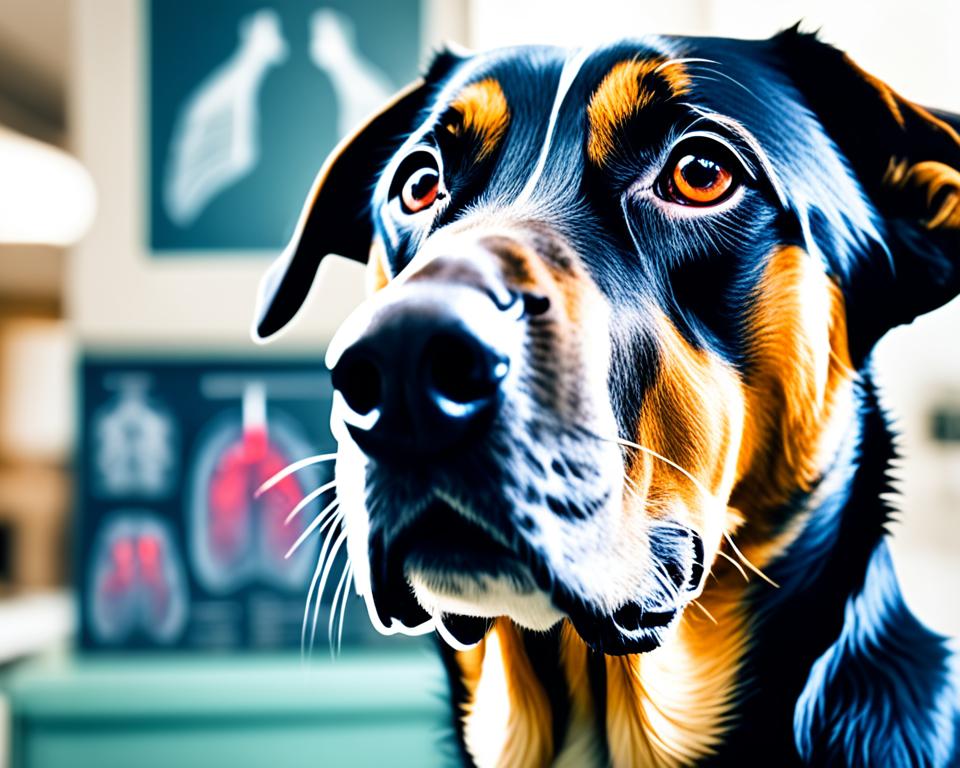
| Respiratory Issues | Signs and Symptoms |
|---|---|
| Pneumonia | Coughing, difficulty breathing, panting |
| Collapsed Trachea | Panting, coughing |
| Chronic Obstructive Pulmonary Disease (COPD) | Difficulty breathing, panting |
| Brachycephalic Airway Syndrome | Panting, breathing difficulties |
Cushing’s Disease and Its Effects on Canine Panting
Cushing’s disease, also known as hyperadrenocorticism, can significantly impact a dog’s respiratory system, leading to excessive panting. This condition occurs when the body produces an excess amount of cortisol, a hormone that regulates various bodily functions.
Excessive panting is one of the common symptoms of Cushing’s disease in dogs. The elevated cortisol levels can cause increased respiratory rate and labored breathing, resulting in noticeable panting, even while at rest.
Along with excessive panting, other symptoms of Cushing’s disease in dogs include increased thirst and urination, weight gain, thinning of the skin, hair loss, and muscle weakness. It’s important to note that these symptoms may vary depending on the severity and duration of the disease.
If you suspect your dog may have Cushing’s disease, it is crucial to consult with a veterinarian for a proper diagnosis. The veterinarian will perform a physical examination and may recommend further tests, such as blood and urine analysis, or imaging studies, to confirm the presence of Cushing’s disease.
Once a diagnosis is confirmed, treatment options for Cushing’s disease may include medication, surgery, or radiation therapy, depending on the underlying cause and the severity of the condition. The goal of treatment is to manage the symptoms, restore hormonal balance, and improve the quality of life for your dog.
Canine Anxiety Disorders: Behavioral Causes of Panting
Behavioral causes, such as anxiety disorders, can contribute to dogs’ panting while they are resting. Dogs, like humans, can experience anxiety and exhibit signs of distress. Pet owners need to recognize the symptoms of dog anxiety in order to address it effectively. Panting is one potential sign of anxiety in dogs, and understanding its connection to canine anxiety disorders is crucial for providing proper care and support to your furry friend.
Spotting Symptoms of Dog Anxiety
Dogs can display various signs that indicate they are experiencing anxiety. Some common symptoms of dog anxiety include:
- Excessive panting
- Restlessness or pacing
- Trembling or shaking
- Sudden house soiling
- Excessive barking or howling
- Destroying furniture or objects
- Attempts to escape or run away
- Loss of appetite
Panting as a Symptom: When to Seek Veterinary Advice
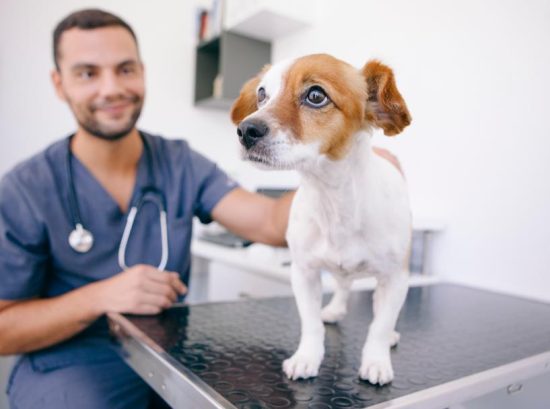
While panting is a natural behavior in dogs, there are certain instances when it may indicate an underlying health issue that requires veterinary attention. Pet owners must be aware of the signs that warrant seeking professional advice for their dog’s panting. By recognizing when excessive panting is a concern, you can ensure the well-being of your furry friend and provide timely medical intervention when necessary.
There are several red flags to look out for that indicate it’s time to reach out to your veterinarian. If your dog is panting excessively without any apparent trigger or external factors, it could cause concern. Additionally, if the panting continues for an extended period or is accompanied by other symptoms such as lethargy, loss of appetite, coughing, or difficulty breathing, it’s important to seek veterinary advice promptly.
FAQs on Why is my dog panting while resting
What causes dog panting while resting?
There are several factors that can contribute to panting in dogs while they are at rest. These include environmental factors such as hot weather or overheating, stress and anxiety-related panting, pain-induced panting, underlying medical conditions, certain medications, and behavioral causes. Identifying the specific cause will help determine the appropriate course of action.
How can I recognize abnormal panting in my dog?
Abnormal panting in dogs can be identified by observing their respiratory rates and differentiating between panting and rapid breathing. If you notice excessive or labored panting that is out of the ordinary, it may be a cause for concern and should prompt further evaluation.
Why is my dog panting while lying down?
Panting while lying down can be a sign of discomfort, pain, anxiety, or an underlying medical condition. It is important to observe any accompanying symptoms and consult with a veterinarian to determine the cause and appropriate treatment for your dog’s panting.
How do I calm a dog down from panting?
Calming a dog down from panting can be achieved by creating a soothing environment, providing a comfortable resting space, using calming techniques such as gentle massage or deep pressure therapy, and addressing any underlying causes of anxiety or stress.
How long should dog panting last?
The duration of dog panting can vary depending on the underlying cause. Normal panting due to heat or exertion typically subsides on its own once the dog has cooled down. However, if the panting persists for an extended period of time or is accompanied by other concerning symptoms, it is advisable to seek veterinary attention.
Should I give a panting dog water?
It is important to provide a panting dog with access to water, especially when they appear to be hot or thirsty. Dogs pant to regulate their body temperature, and providing water can help prevent dehydration. However, if the panting is excessive or accompanied by other concerning symptoms, it is best to consult with a veterinarian for further guidance.





